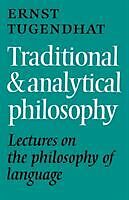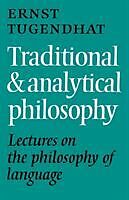Traditional and Analytical Philosophy
Einband:
Kartonierter Einband
EAN:
9780521125734
Untertitel:
Lectures on the Philosophy of Language
Autor:
Ernst Tugendhat, Tugendhat Ernst
Herausgeber:
Cambridge University Press
Anzahl Seiten:
452
Erscheinungsdatum:
31.10.2009
ISBN:
0521125731
Klappentext A study of some of the central and abiding questions of metaphysics and the philosophy of language by Ernst Tugendhat. Zusammenfassung Ernst Tugendhat was trained in the Heideggerian modes of phenomenological and hermeneutical thinking. Yet increasingly he came to believe that the most appropriate approach was from within the framework of analytical philosophy. This book grew out of that conviction! and as such it brought a fresh perspective to some of the rarely examined assumptions and methods of analysis. Inhaltsverzeichnis Preface; Translator's preface; Part I. Introduction: Confrontation of Analytical Philosophy with Traditional Conceptions of Philosophy: 1. A question of method; 2. A philosopher in search of a conception of philosophy; 3. Ontology and semantics; 4. Has formal semantics a fundamental question?; 5. Consciousness and speech; 6. The argument with the philosophy of consciousness continued; 7. A practical conception of philosophy; Part II. A First Step: Analysis of the Predicative Sentence: 8. Preliminary reflections on method and preview of the course of the investigation; 9. Husserl's theory of meaning; 10. Collapse of the traditional theory of meaning; 11. Predicates: the first step in the development of an analytical conception of the meaning of sentences. The dispute between nominalists and conceptualists; 12. The basic principle of analytical philosophy. The dispute continued. Predicates and quasi-predicates; 13. The meaning of an expression and the circumstances of its use. Dispute with a behaviouristic conception; 14. The employment-rule of an assertoric sentence. Argument with Grice and Searle; 15. Positive account of the employment-rule of assertoric sentences in terms of the truth-relation; 16. Supplements; 17. 'And' and 'or'; 18. General sentences. Resumption of the problem of predicates; 19. The mode of employment of predicates. Transition to singular terms; 20. What is it for a sign to stand for an object? The traditional account; 21. The function of singular terms; 22. Russell and Strawson; 23. What is 'identification'?; 24. Specification and identification. Specification and truth; 25. Spatio-temporal identification and the constitution of the object-relation; 26. Supplements; 27. Results; 28. The next steps; Notes; Bibliography; Indexes....
Zusammenfassung
Ernst Tugendhat was trained in the Heideggerian modes of phenomenological and hermeneutical thinking. Yet increasingly he came to believe that the most appropriate approach was from within the framework of analytical philosophy. This book grew out of that conviction, and as such it brought a fresh perspective to some of the rarely examined assumptions and methods of analysis.
Inhalt
Preface; Translator's preface; Part I. Introduction: Confrontation of Analytical Philosophy with Traditional Conceptions of Philosophy: 1. A question of method; 2. A philosopher in search of a conception of philosophy; 3. Ontology and semantics; 4. Has formal semantics a fundamental question?; 5. Consciousness and speech; 6. The argument with the philosophy of consciousness continued; 7. A practical conception of philosophy; Part II. A First Step: Analysis of the Predicative Sentence: 8. Preliminary reflections on method and preview of the course of the investigation; 9. Husserl's theory of meaning; 10. Collapse of the traditional theory of meaning; 11. Predicates: the first step in the development of an analytical conception of the meaning of sentences. The dispute between nominalists and conceptualists; 12. The basic principle of analytical philosophy. The dispute continued. Predicates and quasi-predicates; 13. The meaning of an expression and the circumstances of its use. Dispute with a behaviouristic conception; 14. The employment-rule of an assertoric sentence. Argument with Grice and Searle; 15. Positive account of the employment-rule of assertoric sentences in terms of the truth-relation; 16. Supplements; 17. 'And' and 'or'; 18. General sentences. Resumption of the problem of predicates; 19. The mode of employment of predicates. Transition to singular terms; 20. What is it for a sign to stand for an object? The traditional account; 21. The function of singular terms; 22. Russell and Strawson; 23. What is 'identification'?; 24. Specification and identification. Specification and truth; 25. Spatio-temporal identification and the constitution of the object-relation; 26. Supplements; 27. Results; 28. The next steps; Notes; Bibliography; Indexes.

Leider konnten wir für diesen Artikel keine Preise ermitteln ...
billigbuch.ch sucht jetzt für Sie die besten Angebote ...
Die aktuellen Verkaufspreise von 5 Onlineshops werden in Realtime abgefragt.
Sie können das gewünschte Produkt anschliessend direkt beim Anbieter Ihrer Wahl bestellen.
Loading...
Die aktuellen Verkaufspreise von 5 Onlineshops werden in Realtime abgefragt.
Sie können das gewünschte Produkt anschliessend direkt beim Anbieter Ihrer Wahl bestellen.
| # | Onlineshop | Preis CHF | Versand CHF | Total CHF | ||
|---|---|---|---|---|---|---|
| 1 | Seller | 0.00 | 0.00 | 0.00 |
